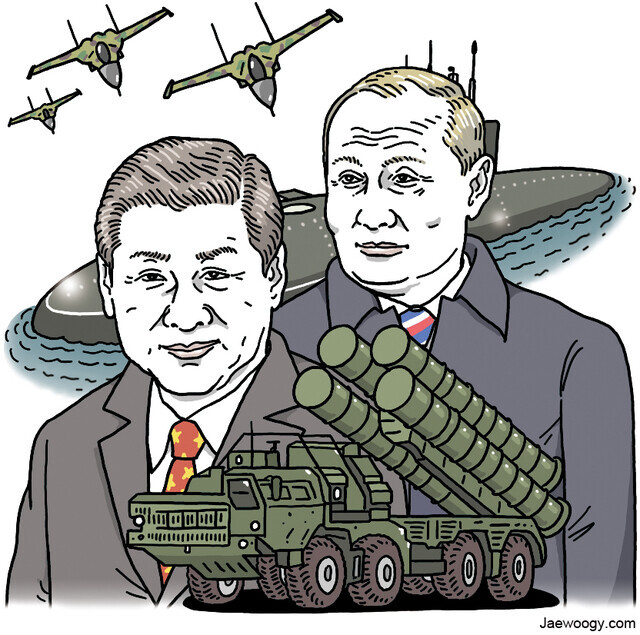hankyoreh
Links to other country sites 다른 나라 사이트 링크
[Column] The cutting-edge weapon Putin gave to Xi

President Vladimir Putin of Russia held another virtual summit with President Xi Jinping of China on Friday. Putin invited Xi for a state visit to Moscow in 2023, stressing the goal of strengthening military cooperation between Russia and China. Suffering from weapon shortages in his invasion of Ukraine, Putin isn’t hiding his burning hope for Chinese military support.
How have Putin and Xi — who have boasted of their “no-limits” partnership — cooperated with one another militarily? According to Norwegian Defense University College professor Tom Røseth’s 2019 essay “Moscow’s Response to a Rising China,” arms deals between Russia and China dramatically changed between 2014 and 2016.
Prior to this, Russia sold a lot of weapons to China, but in doing so, Moscow was extremely careful not to turn over to Beijing cutting-edge weapons or advanced military technology. Even if China and Russia are closely cooperating now, from the Russian perspective, China is a serious potential threat. Russia, with its quickly shrinking population, must inevitably be on guard against its vast Far Eastern and Siberian regions being absorbed into an economically and demographically dominant China’s sphere of influence. Russia took much of this land from Qing dynasty China through unequal treaties in the 19th century.
However, after the West slapped economic sanctions on Moscow after Russia forcibly annexed Ukraine’s Crimean Peninsula in 2014, Putin completely turned toward cooperation with China in defiance of the US-led international order.
Russia began full-scale sales of high-tech weapons and advanced weapon technology to China. Through 2015, Russia signed deals to sell China four Amur-class diesel submarines, 24 Su-35S multirole fighter jets and four S-400 missile defense batteries. This was Russia’s first overseas sale of the advanced S-400, a similar weapon to the THAAD system deployed to USFK.
Starting in 2016, China and Russia began frequent joint military exercises near the South China Sea, Taiwan and the Korean Peninsula. These exercises also signified that Russia was training China on the operation of the cutting-edge weapon systems Moscow had sold to Beijing.
It was around this time that Xi began pushing in earnest military reforms and increased military spending with plans to forcefully unify with Taiwan in mind. Russia’s advanced weapons have been an important factor in China’s “military rise.” China’s weapons industry has quickly grown with the transfer of advanced Russian military technology to Beijing. The market for Chinese weapons is now expanding to African countries like Angola and Nigeria and to other nations such as Myanmar, Serbia, Egypt, Jordan, Saudi Arabia and Pakistan.
Putin must think it’s time for Xi to repay his debt, as they say. Will Xi accede to Putin’s request for military support when he visits Russia this spring? It doesn’t appear likely.
China has been focusing on buying large amounts of cheap oil and gas from Russia, which can no longer sell it to Russia, even as it draws the line at providing military support for Russia’s invasion of Ukraine, fearful of a backlash from the United States and Europe. China is even expanding its influence in Central Asia, Russia’s “backyard.”
Will history remember Putin, who talks of restoring Russia’s glory as a great Eurasian empire, as the man who turned Russia into a Chinese vassal state?
By Park Min-hee, editorial writer
Please direct questions or comments to [english@hani.co.kr]

Editorial・opinion
![[Column] When ‘fairness’ means hate and violence [Column] When ‘fairness’ means hate and violence](https://flexible.img.hani.co.kr/flexible/normal/500/300/imgdb/original/2024/0516/7417158465908824.jpg) [Column] When ‘fairness’ means hate and violence
[Column] When ‘fairness’ means hate and violence![[Editorial] Yoon must stop abusing authority to shield himself from investigation [Editorial] Yoon must stop abusing authority to shield himself from investigation](https://flexible.img.hani.co.kr/flexible/normal/500/300/imgdb/original/2024/0516/4417158464854198.jpg) [Editorial] Yoon must stop abusing authority to shield himself from investigation
[Editorial] Yoon must stop abusing authority to shield himself from investigation- [Column] US troop withdrawal from Korea could be the Acheson Line all over
- [Column] How to win back readers who’ve turned to YouTube for news
- [Column] Welcome to the president’s pity party
- [Editorial] Korea must respond firmly to Japan’s attempt to usurp Line
- [Editorial] Transfers of prosecutors investigating Korea’s first lady send chilling message
- [Column] Will Seoul’s ties with Moscow really recover on their own?
- [Column] Samsung’s ‘lost decade’ and Lee Jae-yong’s mismatched chopsticks
- [Correspondent’s column] The real reason the US is worried about Chinese ‘overcapacity’
Most viewed articles
- 1Could Korea’s Naver lose control of Line to Japan?
- 2[Column] Welcome to the president’s pity party
- 3[Column] US troop withdrawal from Korea could be the Acheson Line all over
- 4Naver’s union calls for action from government over possible Japanese buyout of Line
- 5[Editorial] Korea must respond firmly to Japan’s attempt to usurp Line
- 6Korea cedes No. 1 spot in overall shipbuilding competitiveness to China
- 7[Editorial] Yoon must stop abusing authority to shield himself from investigation
- 8[Column] When ‘fairness’ means hate and violence
- 9Korean opposition decries Line affair as price of Yoon’s ‘degrading’ diplomacy toward Japan
- 10Second suspect nabbed for gruesome murder of Korean in Thailand, 1 remains at large